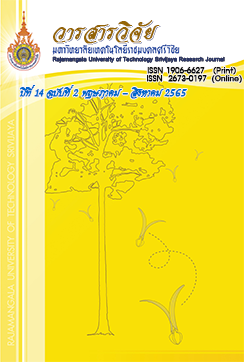สาหร่ายลดโลกร้อน
คำสำคัญ:
สาหร่าย, การลดก๊าซคาร์บอนไดออกไซด์, ก๊าซเรือนกระจกบทคัดย่อ
การเพิ่มขึ้นอย่างต่อเนื่องของปริมาณก๊าซคาร์บอนไดออกไซด์ เป็นสาเหตุหลักในการเกิดก๊าซเรือนกระจกนับเป็นปัญหาท้าท้ายด้านสิ่งแวดล้อมที่สำคัญในระดับโลก การวิจัยในครั้งนี้มีวัตถุประสงค์เพื่อศึกษาการลดก๊าซคาร์บอนไดออกไซด์ของสาหร่ายจำนวน 3 ชนิด ได้แก่ Chlorella sp., Spirulina sp. และ Scenedesmus sp. โดยทำการเพาะเลี้ยงสาหร่ายในถังปฏิกิริยาปริมาตรสาหร่าย 5 ลิตร ให้ความเข้มแสงที่ 4,000 ลักซ์ และให้อากาศ โดยการเติมก๊าซคาร์บอนไดออกไซด์ร้อยละ 99 ที่อัตราการไหล 0.05 vvm อย่างต่อเนื่อง เป็นเวลา 20 วัน ผลการศึกษา พบว่า สาหร่าย Chlorella sp. มีประสิทธิภาพในการลดก๊าซคาร์บอนไดออกไซด์สูงสุด โดยมีค่าอัตราการเจริญเติบโตจำเพาะสูงสุด 0.43±0.05 ต่อวัน มีค่าความหนาแน่นของเซลล์สาหร่าย (OD560) สูงสุดถึง 0.62±0.02 มวลสาหร่ายสูงสุด 2,166.70±57.70 มิลลิกรัมต่อลิตร ประสิทธิภาพในการลดปริมาณก๊าซคาร์บอนไดออกไซด์สูงสุดร้อยละ 97.33±0.58 อัตราการตรึงก๊าซคาร์บอนไดออกไซด์สูงสุดถึง 4,073.30±108.50 มิลลิกรัมต่อลิตรต่อวัน และค่าประสิทธิภาพการกักเก็บคาร์บอนเฉลี่ยต่อ 20 วัน คือ 3.88±0.01 โมล จากการวิเคราะห์ค่าทางสถิติ พบว่า การลดก๊าซคาร์บอนไดออกไซด์ และการกักเก็บคาร์บอนแตกต่างอย่างมีนัยสำคัญทางสถิติ (p<0.05)
เอกสารอ้างอิง
Ahn, J.W., Hwangbo, K., Lee, S.Y., Choi, H.G., Park, Y.l., Liu, J.R. and Jeong, W.J. 2012. Shorth communication anew arctic Chlorella species for biodiesel production. Bioresource Technology 125: 340-343.
Barsanti, L. and Gualtieri, P. 2014. Algae Anatomy, Biochemistry, and Biotechnology. 2nd ed. Taylor & Francis Group, NewYork.
Chan, A. 2011. Use of microalgae in wastewater treatment to remove contaminants and purify biogas. Master of Applied Science, The University of Guelph, Canada.
Chidthaisong, A. 2010. Thailand Climate Change Information. The Thailand Research Fund’s Research development and Co-ordination Center for Global Warming and Climate Change, Bangkok. (in Thai)
Chiu, S.Y., Kao, C.Y., Huang, T.T., Lin, C.J., Ong, S.C., Chen, C.D., Chang, J.S. and Lin, C.S. 2011. Microalgal biomass production and on-site bioremediation of carbon dioxide, nitrogen oxide and sulphur dioxide from flue gas using Chlorella sp. cultures. Bioresource Technology 102: 9135-9142.
Ho, S.H., Chen, C.Y., Lee, D.J. and Chang, J.S. 2011. Research review paper: Perspectives on microalgle CO2-emission mitigation systems - A review. Biotechnology Advances 29: 189-198.
Kao, C.Y., Chiu, S.Y., Huang, T.T., Dai, L., Hsu, L.K. and Lin, C.S. 2012a. Ability of a mutant strain of microalgae Chlorella sp. to capture carbon dioxide capture for biogas upgrading. Applied Energy 39: 76-183.
Kao, C.Y., Chiu, S.Y., Huang, T.T., Dai, L., Wang, G.H, Tseng, C.P., Chen, C.H. and Lin, C.S. 2012b. A mutant strain of microalgae Chlorella sp. for the carbon dioxide capture from biogas. Biomass and Bioenergy 36: 32-140.
Kargupta, W., Ganesh, A. and Mukherji, S. 2015. Estimation of carbon dioxide sequestration Potential of microalgae grown in a batch photobioreactor: Short Communication. Bioresource Technology 180: 370-375.
Lane, A.E. and Burris, J.E. 1981. Effects of environmental pH on the internal pH of Chlorella pyrenoidosa, Scenedesmus quadricauda and Euglena mutablis. Plant Physiol 68: 439-442.
Li, F.F., Yang, Z., Zeng, R., Yang, G., Chang, X., Yan, J.B. and Hou, Y.L. 2011. Microalgae capture of CO2 from actual flue gas discharged from a combustion chamber. Industrial & Engineering Chemistry Research 50(10): 6496-6502.
Man, K.L. and Keat, T.L. 2013. Effect of carbon source towards the growth of chlorella vulgaris for CO2 bio-mitigation and biodiesel production. International Journal of Greenhouse Gas Control 14: 169-176.
Mann, G., Schlegel, M., Schumann, R. and Sakalauskas, A. 2009. Biogas-condition with microalgae. Agronomy Research 7(1): 33-38.
Morais, M.G.D. and Costa, J.A.V. 2007. Carbon dioxide fixation by Chlorella kessleri, Chlorella vulguris, Scenedesmus obliquus and Spirulina sp. cultivated in flasks and vertical tubular photobioreactors. Biotechnol Lett 29: 1349-1352.
Ngoenkhamkhong, K., Cheunbarn, S., Cheunbaen, T. and Ngoenkhamkhong, N. 2017. The Efficiency of CO2 Capture by Green Microalgae. RMUTI Journal 10(2): 119-129. (in Thai)
Oliveira, M.A.C., Monteiro, L.D., Robb, P.G. and Leite, S.G.F. 1999. Growth and Chemical composition of Spirulina maxima and Spirulina patensis biomass at different temperature. Aquaculture International 7: 261-275.
Ren, H.Y., Liu, B.F., Ma, C., Zhao, L. and Ren, N.Q. 2013. A new lipid-rich microalga Scenedesmus sp. strain R-16 isolated using Nile red staining: effects of Carbon and nitrogen sources and initial pH on the biomass and lipid production. Biotechnology for biofuels 6(143): 1-10.
Serejo, M.L., Olmos, E.P., Boncz, M., Blanco, S., Garcia-Encina, P.A. and Munoz, R. 2015. Influence of biogas flow rate on biomass composition during the optimization of biogas upgrading in microalgal-bacterial process. Environmental Science & Technology 49(5): 1-16.
Shuler, M.L., Kargi, F. and De Lisa, M. 1922. Bioprocess engineering: basic concept. 3rd ed. Prentical Hall, Englewood Cliffis New Jersey, United State.
Srethasirot, B., Chidthaisong, A. and Chinwanno, S. 2014. Climate@risk. Bangkok Business Publishing, Bangkok. (in Thai)
Sumardiono, S., Yono, B., Syaichurrozi, I. and Sasongko, S.B. 2014. Utilization of biogas as carbon dioxide provider for Spirulina platensis culture. Biological Sciences 6(1): 53-59.
Toledo-Cervantes, A., Morales, M., Novelo, E. and Revah, S. 2013. Carbon dioxide fixation and lipid storage by Scenedesmus obtusiusculus. Bioresource Technology 130: 652-658.
Tongprawhan, W., Srinuanpa, S. and Cheirsilp, B. 2014. Biocapture of CO2 from biogas by Oleaginous microalgae for improving methane content and simultaneously producing lipid. Bioresource Technology 170: 90-99.
Zeng, X., Danquah, M.K., Zhang, S., Zhang, X., Wu, M., Chen, X.D., Ng, I.S., Jing, K. and Lu, Y. 2012. Autotrophic cultivation of Spirulina platensis for CO2 fixation and phycocyanin production. Chemical Engineering 183: 192-197.
ดาวน์โหลด
เผยแพร่แล้ว
รูปแบบการอ้างอิง
ฉบับ
ประเภทบทความ
สัญญาอนุญาต
ลิขสิทธิ์ (c) 2022 วารสารวิจัย มหาวิทยาลัยเทคโนโลยีราชมงคลศรีวิชัย

อนุญาตภายใต้เงื่อนไข Creative Commons Attribution-NonCommercial-NoDerivatives 4.0 International License.
เนื้อหาและข้อมูลในบทความที่ลงตีพิมพ์ในวารสารวิจัยมหาวิทยาลัยเทคโนโลยีราชมงคลศรีวิชัย ถือเป็นข้อคิดเห็นและความรับผิดชอบของผู้เขียนบทความโดยตรง ซึ่งกองบรรณาธิการวารสารไม่จำเป็น ต้องเห็นด้วย หรือร่วมรับผิดชอบใดๆ
บทความ ข้อมูล เนื้อหา รูปภาพฯลฯ ที่ได้รับการตีพิมพ์ในวารสารวิจัย มหาวิทยาลัยเทคโนโลยีราชมงคลศรีวิชัย ถือเป็นลิขสิทธ์ของวารสารวิจัย มหาวิทยาลัยเทคโนโลยีราชมงคลศรีวิชัย หากบุคคลหรือหน่วยงานใดต้องการนำทั้งหมดหรือส่วนหนึ่งส่วนใดไปเผยแพร่ต่อหรือเพื่อการกระทำการใดๆจะต้องได้รับอนุญาตเป็นลายลักษ์อักษรจากวารสาร มหาวิทยาลัยเทคโนโลยีราชมงคลศรีวิชัยก่อนเท่านั้น







